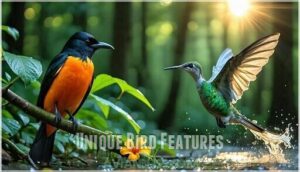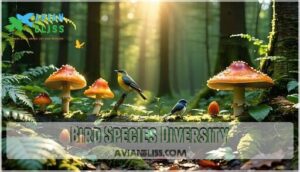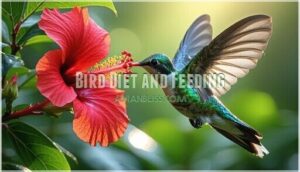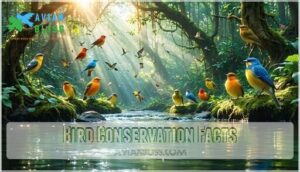This site is supported by our readers. We may earn a commission, at no cost to you, if you purchase through links.
 Birds are fascinating creatures that come in all shapes and sizes, perfect for your school project.
Birds are fascinating creatures that come in all shapes and sizes, perfect for your school project.
They have hollow bones that make them light for flight and feathers that help with warmth, flying, and even attracting mates.
You’ll find birds like eagles with sharp beaks for tearing meat, while hummingbirds use long, thin beaks for sipping nectar.
Did you know some birds, like penguins, can’t fly but are amazing swimmers? Others, like Arctic terns, travel thousands of miles during migration.
Whether it’s their calls, intricate nests, or colorful feathers, birds are full of surprises—there’s always more to discover, with amazing abilities.
Table Of Contents
- Key Takeaways
- Bird Physical Traits
- Bird Behavior Patterns
- Bird Species Diversity
- Bird Diet and Feeding
- Bird Conservation Facts
- Frequently Asked Questions (FAQs)
- What is a bird fact for kids?
- What are some fun facts about bird watching?
- What are some fun facts about birds?
- What do birds eat facts for kids?
- What are some rare facts about birds?
- What are some fun facts about go away birds?
- How long do different bird species typically live?
- What time of day are most birds active?
- How do birds communicate with other bird species?
- Which birds can learn to mimic human speech?
- Conclusion
Key Takeaways
- Birds have unique physical traits like hollow bones for flight and specialized beaks designed for their diets.
- Many birds migrate thousands of miles, using the sun, stars, and Earth’s magnetic field to navigate.
- Birds communicate through songs and calls, and even mimicry, helping them warn of predators or attract mates.
- Conservation efforts are crucial as habitat loss, climate change, and pollution threaten bird populations.
Bird Physical Traits
Birds have fascinating physical traits that help them survive and thrive in different environments.
From hollow bones for flight to beaks designed for specific diets, their bodies are perfectly adapted for their lifestyles.
Hollow Bones and Flight
Understanding bird anatomy reveals how hollow bones play a key role in flight mechanics.
Hollow bones are nature’s lightweight marvel, giving birds the strength and efficiency needed to master the skies.
These lightweight, air-filled bones reduce weight while maintaining strength, giving birds an evolutionary advantage for soaring skies.
This unique bone structure helps balance weight reduction with durability, making flight efficient.
Pneumatic bones also enhance respiration.
It’s a fascinating feature of bird bones, showcasing nature’s brilliance in designing creatures perfectly adapted for flight.
Beak Shapes and Functions
A bird’s beak is like a tool, perfectly shaped for its diet.
Beak morphology shows amazing diversity, reflecting feeding adaptations over time.
Here are three examples:
- Meat-eating birds, like eagles, have sharp, curved beaks for tearing prey.
- Hummingbirds use long, thin beaks to sip nectar.
- Ducks have flat beaks, ideal for scooping plants and small creatures, which is a result of their specific diet.
Feather Characteristics and Uses
Feathers aren’t just for flying—they’re multi-taskers! They provide insulation, waterproofing, and even vibrant coloration for display.
Bird feathers have a strong yet lightweight structure, perfect for flight. Feathers make bird wings remarkable!
| Feather Feature | Function |
|---|---|
| Feather Structure | Supports flight |
| Feather Coloration | Attracts mates |
| Feather Insulation | Keeps birds warm |
| Feather Waterproofing | Shields from rain |
| Feather Molting | Replaces old feathers |
Unique Bird Features
Some bird adaptations are truly fascinating!
Did you know the hooded pitohui is one of the only poisonous birds?
Hummingbirds, with their backward flight, are nature’s tiny acrobats.
And let’s not forget ostriches—flightless birds that run faster than most animals.
These unique bird species showcase incredible traits like colorful eggs, the largest wingspan, and remarkable survival skills.
Bird Behavior Patterns
Birds show fascinating behavior patterns that help them survive and interact with their environment. From migrating across continents to using calls for communication, their actions are both purposeful and unique.
Communication Methods
Bird communication is fascinating!
Vocalizations like songs and calls help birds share information.
Songs are often used for courtship displays or marking territory, while alarm calls warn of predators.
Flocking signals keep groups organized during flight.
These bird facts for school projects show how bird behavior relies on sound to survive and thrive.
Bird songs truly reveal nature’s melodies!
Social Interactions and Flocking
In bird communities, flocking benefits include predator avoidance and better foraging.
Birds in flocks use communication signals to share food locations or warn of danger.
Social hierarchy often forms, helping maintain order, and some species, like crows, even engage in cooperative hunting.
This bird behavior strengthens bird social behavior, ensuring survival and creating tightly-knit bird flocks with shared responsibilities.
Migration and Navigation
Twice a year, many birds set out on long journeys called migrations.
Migrating birds embark on epic journeys twice a year, navigating with the sun, stars, and Earth’s magnetic field.
Migration triggers include changes in daylight and food availability.
Birds use navigation methods like the sun, stars, and Earth’s magnetic field.
Stopover ecology is vital, as birds rest and refuel at key spots.
Flyway conservation helps protect these pathways, especially with climate impacts threatening bird migration.
Fascinating bird facts for school projects, including the importance of conservation.
Courtship and Mating Rituals
In bird courtship, males often use ritualistic displays like dancing, singing, or showing off colorful feathers to attract females.
Mate selection varies; some birds form monogamous pairs, while others practice polygamy.
Nest building is a key part of bird mating, with both male and female birds contributing to the process, which is crucial for parental care and ultimately affects bird reproduction.
Bird Species Diversity
Birds come in an incredible variety, with around 10,000 species found worldwide, from the tiny bee hummingbird to the towering ostrich.
Each species is uniquely adapted to its environment, whether it’s soaring over oceans or living on the forest floor.
Largest and Smallest Bird Species
Did you know the ostrich is the largest bird, standing up to 9 feet tall? In contrast, the bee hummingbird, the smallest bird, measures just 2 inches!
Here are some cool bird facts for school projects:
- The albatross has the largest wingspan, over 11 feet.
- Kiwi eggs are huge compared to their body size.
- Weight comparisons reveal incredible size diversity.
Bird Species and Their Habitats
From towering ostriches in African savannas to tiny hummingbirds in tropical forests, bird species thrive in diverse habitats.
Their biogeographic distribution depends on habitat specificity and niche partitioning, ensuring survival.
For example, penguins dominate icy regions, while flamingos prefer saline lakes.
Habitat loss threatens many birds, impacting their conservation status. These bird facts for school projects highlight nature’s balance in bird habitats, and the importance of understanding habitat specificity.
Unique Bird Characteristics
Did you know some birds have characteristics that seem straight out of animal facts books?
The hooded pitohui is one of the only poisonous birds, while kiwis are flightless yet lay enormous eggs for their size.
Birds also have incredible senses—owls can hear prey before seeing it.
These bird facts make perfect additions to student projects, with incredible senses being a key aspect of what makes them fascinating.
Endangered Bird Species
Endangered birds remind us how fragile nature can be.
Habitat loss, climate change, and poaching threats put species like the Northern Bald Ibis at risk.
Conservation efforts, like breeding programs, help protect them.
The IUCN Red List classification monitors the conservation status of over 11,000 bird species.
- Over 460 bird species are endangered globally.
- The Regent Honeyeater has fewer than 400 left in the wild.
- Bird conservation guarantees future generations enjoy these wonders.
Bird Diet and Feeding
Birds eat a wide variety of foods, from seeds and fruits to insects and small animals, depending on their species.
Their beaks and feeding habits are specially adapted to help them find, catch, and digest their meals efficiently, which is a complete concept related to how birds eat.
Omnivorous and Carnivorous Birds
Omnivorous and carnivorous birds have fascinating dietary adaptations.
Meat-eaters, like hawks and owls, use sharp beaks and talons for hunting techniques, while omnivores, such as crows, mix plant food and scavenging behavior.
Here’s a quick look:
| Bird Type | Prey Selection | Digestive Systems |
|---|---|---|
| Hawks | Small mammals | Designed for digesting meat |
| Crows | Insects, fruits | Flexible to varied bird diet |
| Vultures | Carcasses | Strong stomach acid for scavenging |
The table highlights the unique characteristics of each bird type, including their prey selection and digestive systems, showcasing the diversity of bird diets and their adaptations for survival.
Herbivorous and Nectarivorous Birds
Herbivorous and nectarivorous birds have fascinating diets. Some eat fruits and help with plant seed dispersal, while others, like hummingbirds, sip nectar with long beaks, aiding pollination syndromes.
Nectar composition plays a big role in attracting birds to flowers, where floral specialization matches specific birds. Digestive adaptations also allow these birds to process sugar-rich diets efficiently.
Great bird facts for student projects, including how plant seed dispersal occurs.
Bird Eating Habits and Digestion
Did you know birds have unique ways to eat and digest food? Their gizzard acts like a stomach grinder, breaking food down since they lack teeth.
Birds adapt their diet to their lifestyle and environment. Here’s more:
- Meat-eaters: Tear prey with sharp beaks.
- Seed-eaters: Have tough beaks for cracking.
- Prey digestion: Simplified for energy.
- Gizzard function: Essential for grinding.
- Feeding behaviors: Match nutritional needs.
Adaptations for Food Gathering
Birds have incredible adaptations for food gathering.
Beak specializations, like curved beaks for hunting or flat ones for scooping, match their diet.
Tongue adaptations help nectar-feeders like hummingbirds reach deep flowers.
The gizzard function grinds tough food.
Hunting strategies vary; falcons dive fast, while herons wade patiently.
Some birds store food in hidden spots, showcasing smart bird foraging behaviors and resourceful bird feeding methods.
Plumage also contributes, with some species using cryptic colors for camouflage while foraging, demonstrating resourceful adaptations.
Bird Conservation Facts
Bird conservation helps protect bird species from threats like habitat loss, pollution, and climate change.
By preserving their environments and understanding their migration patterns, you can guarantee birds continue to thrive, which is crucial for their survival and supports the overall goal of bird conservation.
Threats to Bird Populations
Birds face many threats today, including habitat loss from deforestation and urbanization, climate change disrupting migration, and bird predators like domestic cats.
Pollution impacts their health, while invasive species compete for resources. Even human-caused hunting effects and window collisions harm populations.
To protect birds from predators, consider installing a protective barrier device. Understanding these challenges highlights the importance of bird conservation efforts to protect diverse bird habitats and maintain their conservation status.
Importance of Habitat Preservation
Protecting bird habitats keeps ecosystems healthy and balanced. Every bird depends on its environment for shelter, food, and survival.
Habitat loss threatens species interdependence, making conservation efforts essential. By supporting sustainable practices, like planting trees or reducing pollution, you’re helping preserve bird ecosystems.
These bird facts for school projects highlight simple ways to protect bird habitats while promoting environmental education and awareness. You can also purchase items here that help support conservation.
Bird Migration and Conservation
Bird migration showcases amazing journeys across continents. Unfortunately, habitat loss and climate change threaten these routes.
Conservation efforts help provide safe spaces and resources to protect species and prevent decline. Here are key bird facts for school projects:
- Migration routes link breeding and feeding areas.
- Species face risks like habitat destruction.
- Conservation protects important areas.
- Climate change adds new challenges.
To help, individuals can support reducing pesticide use to make a positive impact on bird conservation.
Human Impact on Bird Species
Human activities like habitat loss, climate change, and pollution effects harm bird ecology, affecting their conservation status.
Hunting impacts many species, while changing environments disrupt migration.
Conservation efforts, like protecting wetlands and creating bird reserves, help maintain balance.
These actions highlight the importance of bird protection.
Understanding human impact on birds is essential for conservation.
Including this in bird facts for kids’ projects shows how small actions support bird conservation efforts.
Frequently Asked Questions (FAQs)
What is a bird fact for kids?
The ostrich is the world’s largest bird, standing up to 9 feet tall and running faster than most cars in a school zone—43 mph!
It lays the largest eggs, weighing about 3 pounds!
What are some fun facts about bird watching?
Watching birds feels like discovering nature’s treasure chest.
You’ll spot vibrant colors, graceful movements, and hear fascinating calls.
Birds flock together, migrate vast distances, and display unique behaviors—each observation is like discovering a new secret.
What are some fun facts about birds?
Some birds fly over 70 mph, while hummingbirds can hover and even fly backwards.
Bald eagles mate for life, and flamingos turn pink from their diet.
Fun fact: chickens are distant relatives of dinosaurs!
What do birds eat facts for kids?
Birds eat different foods depending on their species.
Some eat seeds, fruits, or worms, while others enjoy fish and insects.
Hummingbirds drink nectar, and owls hunt small prey like mice using their sharp senses.
What are some rare facts about birds?
Some birds see ultraviolet light, others, like crows, make tools.
Penguins swim up to 25 mph, while hummingbirds fly backwards.
The hooded pitohui is poisonous, and flamingos turn pink from eating beta-carotene-rich food!
What are some fun facts about go away birds?
Go-away birds, found in Africa, get their name from their loud “go away” call.
They eat fruit, flowers, and leaves, using their long tails for balance.
Their sleek gray feathers make them easy to spot, with sleek gray feathers being a notable characteristic.
How long do different bird species typically live?
Lifespans vary by species. Small birds, like finches, live 2-5 years, while larger ones, like eagles, can reach 20-30 years. Parrots often outlive humans, living 50-80 years or more!
What time of day are most birds active?
Most birds are diurnal, meaning they’re most active during daylight hours, especially at dawn and dusk.
These times are ideal for feeding, socializing, and avoiding predators, making mornings and evenings their busiest periods.
How do birds communicate with other bird species?
You might think birds only communicate within their species, but they often share calls or mimic sounds to warn of predators or signal food.
For example, mockingbirds imitate others, creating a universal “language” in nature, which can be seen as a form of communication.
Which birds can learn to mimic human speech?
Parrots, mynahs, and some crows can mimic human speech.
They don’t just copy sounds; they use their complex vocal cords and intelligence to imitate words.
With patience, you could teach them simple phrases too!
Conclusion
Did you know there are over 10,000 bird species worldwide, each with unique traits?
From hollow bones to colorful feathers, birds showcase incredible adaptations. Their beaks, diets, and behaviors reveal how they thrive in diverse habitats.
Whether it’s migration spanning thousands of miles or intricate courtship rituals, birds are full of surprises.
For your school project, exploring bird facts can uncover amazing details about their lives, helping you appreciate their role in nature and conservation efforts.
- https://www.nationalgeographic.com/subscribe/kids-magazines?cmpid=int_org=ngp::int_mc=website::int_src=ngp::int_cmp=subs_kids::int_add=kids_hp_nav
- https://disneytermsofuse.com/english/
- https://privacy.thewaltdisneycompany.com/en/current-privacy-policy/
- https://ninos.kiddle.co/Aves
- https://www.audubon.org/news/hummingbird-flight-nothing-else-bird-world














